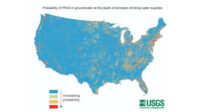'Forever Chemicals' in Wastewater Threaten Drinking Water for Millions, Study Finds
Even advanced wastewater treatment removes less than 25% of organic fluorine

Source: Western Virginia Water Authority
A groundbreaking multi-university study has revealed an alarming presence of "forever chemicals" in America's wastewater system, with pharmaceutical compounds making up an unexpected majority of these persistent substances. The research, published in the Proceedings of the National Academy of Sciences (PNAS), suggests that millions of Americans could be unknowingly exposed to these chemicals through their drinking water.
The study found that common prescription drugs constitute approximately 75% of organic fluorine in wastewater entering treatment plants, with 62% remaining in treated water released into the environment. More concerning still, current water treatment methods prove largely ineffective against these substances.
"We've been focused on a small subset of these chemicals, but that's just the tip of the iceberg," said Bridger J. Ruyle, an incoming Assistant Professor at NYU Tandon School of Engineering's Civil and Urban Engineering department, who led the study. "The research shows that even advanced wastewater treatment removes less than 25% of these compounds before they're discharged into rivers and streams."
Widespread Impact
The research team's national model estimates that during normal river conditions, approximately 15 million Americans receive drinking water containing levels of these compounds above regulatory limits. This number could surge to 23 million people during drought conditions.
The study's scope was comprehensive, examining eight major wastewater treatment facilities serving metropolitan areas across the United States. These facilities mirror those serving about 70% of the U.S. population, suggesting nationwide implications.
Beyond Current Regulations
The findings reveal a significant gap in current regulatory oversight. The six forever chemicals recently regulated by the Environmental Protection Agency in drinking water represent only about 8% of the organic fluorine found in wastewater effluent. The majority consists of unregulated fluorinated pharmaceuticals and other compounds.
"What's particularly troubling is that these fluorinated pharmaceuticals are designed to be biologically active at very low doses," Ruyle explained. "We don't yet understand the public health implications of long-term exposure to these compounds through drinking water."
Growing Concern
The timing of these findings is particularly critical, as approximately 20% of all pharmaceuticals now contain fluorine. While this chemical element enhances drug effectiveness by increasing their persistence in the body, it also means these compounds don't break down in the environment.
"These results emphasize the urgent need to reduce ongoing sources of these chemicals and evaluate the long-term effects of fluorinated pharmaceuticals in our water supply," said Ruyle. "We can't just focus on the handful of compounds we've studied extensively while ignoring the majority of what's actually out there. We need a more comprehensive approach to regulation and increased attention to the ecological and public health impacts of fluorinated pharmaceuticals."
The research was supported by the National Institute for Environmental Health Science Superfund Research Program and the Water Research Foundation, with additional contributions from participating wastewater treatment facilities.



